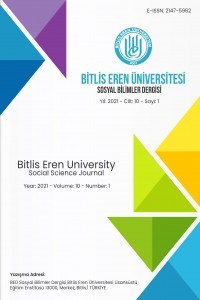Turist Gelişleri Durağan mı? En Çok Ziyaret Edilen 10 Ülke İçin Fourier Panel Durağanlık Testi
Turizm, dünyada hızla gelişen ve genişleyen sektörlerden biridir. Turizm sektörü, gelir getirici ve istihdamı artırıcı etkisiyle ülkeler için refahın artmasına ve sürdürülebilir kalkınmaya katkıda bulunmaktadır. Ayrıca sosyal ve kültürel etkileşim sağlayarak dünya barışının korunmasında önemli bir role sahiptir. Turizm endüstrisi daha iyi bir gelecek inşa etmenin bir yoludur. Bu nedenle turizm endüstrisinin iyi yönetimi politika yapıcılar için oldukça önemlidir. Bu çalışmada, 1995-2019 verileri kullanılarak, dünyada en çok ziyaret edilen 10 ülke için turizmi etkileyen şokların etkilerinin geçici mi yoksa kalıcı mı olduğunu incelemek için Fourier panel durağanlık testi kullanılmıştır. Turist gelişleri dizisinin panelin tümü için durağan olduğu, diğer bir deyişle şokların etkisinin geçici olduğu sonucuna varılmıştır.
Anahtar Kelimeler:
Turizm, Turist Gelişleri, Durağanlık, Fourier Panel Birim Kök Testi
___
- Baig, S., & Hussain, H. (2020). Do shocks have permanent or transitory effects on tourist inflow? An application of stationarity test with structural breaks: evidence reexamined for Gilgit-Baltistan, Pakistan. Asia Pacific Journal of Tourism Research, 25(2), 120-130.
- Bassil, C., Saleh, A. S., & Anwar, S. (2014). Is tourism in Lebanon subject to permanent or transitory exogenous shocks?. Tourism Analysis, 19(6), 781-790.
- Becker, R., Enders, W., & Lee, J. (2006). A stationarity test in the presence of an unknown number of smooth breaks. Journal of Time Series Analysis, 27(3), 381-409.
- Bhattacharya, M., & Narayan, P. K. (2005). Testing for the random walk hypothesis in the case of visitor arrivals: Evidence from Indian tourism. Applied Economics, 37(13), 1485-1490.
- Breusch, T. S., & Pagan, A. R. (1980). The lagrange multiplier test and its applications to model specification in econometrics. The Review of Economic Studies, 47(1), 239-253.
- Charles, A., Darné, O., & Hoarau, J. F. (2019). How resilient is La réunion in terms of international tourism attractiveness: An assessment from unit root tests with structural breaks from 1981-2015. Applied Economics, 51(24), 2639–2653.
- Dash, A. K., KG, S., & Tiwari, A. K. (2017). Are tourist arrivals stationary? Evidence from BRIC countries. Current Issues in tourism, 20(3), 221-224.
- Dedeoğlu, M. (2013). Are shocks to Turkey’s tourist arrivals permanent? Ekonometri ve İstatistik e-Dergisi, (24), 30-39.
- Gil-Alana, L. A., Mervar, A., & Payne, J. E. (2016). Modeling the degree of persistence in Croatian tourism. Tourism Economics, 22(3), 655-664.
- Hsueh, S. J., Hu, Y. H., & Tu, C. H. (2013). Economic growth and financial development in Asian countries: A bootstrap panel Granger causality analysis. Economic Modelling, 32, 294-301.
- Kyophilavong, P., Tiwari, A. K., Jóźwik, B., & Kikuchi, T. (2019). Are tourist arrivals stationary? Evidence from Laos. Anatolia, 30(4), 622-625.
- Lee, C. G. (2010). Whether a shock has a temporary or permanent effect on visitor arrivals in Singapore. Tourism Review International, 14(1), 43-46.
- Nazlioglu, S., & Karul, C. (2017). A panel stationarity test with gradual structural shifts: Re-investigate the international commodity price shocks. Economic Modelling, 61, 181-192.
- Pesaran, M. H. (2006). Estimation and inference in large heterogeneous panels with a multifactor error structure. Econometrica, 74(4), 967-1012.
- Pesaran, M., H., Ullah, A., & Yamagata, T. (2008). A bias-adjusted LM test of error cross-section ındependence. Econometrics Journal, 11, 105-127.
- Saleh, A. S., Verma, R., & Ihalanayake, R. (2011). Do external shocks have a permanent or a transitory effect on Thailand's tourism industry?. Tourism Analysis, 16(4), 483-491.
- Tan, S. H., & Tan, S. K. (2014). Are shocks to Singapore's tourist arrivals permanent or transitory? An application of stationarity test with structural breaks. Current Issues in Tourism, 17(6), 480-486.
- Tiwari, A. K., Dash, A. K., & Narayanan, B. G. (2018). Foreign tourist arrivals in India from major source countries: An empirical analysis. Current issues in Tourism, 21(10), 1137-1156.
- UNWTO, (2019). (https://www.e-unwto.org/doi/pdf/10.18111/9789284421152)
- WTTC (2020). (www.e-unwto.org/loi/wtobarometereng)
- WTTC (2021). (https://wttc.org/Research/Economic-Impact)
- Xie, H., Tiwari, A. K., & Chang, T. (2018). Investigating stationarity in tourist arrivals to India using panel KPSS with sharp drifts and smooth breaks. Applied Economics, 50(46), 4985-4998.
- Yucel, A. G. (2020). Are shocks to tourist arrivals permanent or transitory? A comprehensive analysis on the top 20 most-visited countries. Current Issues in Tourism, 1-18.
- ISSN: 2147-5962
- Yayın Aralığı: Yılda 2 Sayı
- Başlangıç: 2012
- Yayıncı: Bitlis Eren Üniversitesi
Sayıdaki Diğer Makaleler
Lokasyon Katsayısı Yaklaşımı İle Türkiye Çimento Sanayiinde Bölgesel Yoğunlaşma
Muşlu Şair Nûrî’nin Adnan Menderes’e Yazdığı Kürtçe Mersiyeler
Yabancılaşma: Marx’ın Teorisine Bir Giriş, Dan Swain, çev. Hande T. Urbarlı, İstanbul, 2013, 108 s.
Kur’ân Tilavetinde Lahn Olgusu ve Fatiha Suresindeki Yansıması
Kars Müzesi’nde Bulunan Bir Grup Kemer ve Tokaları
Sözlü Tarih ve Bir Yerel Tarih Yazımı Denemesi: Urfa Horoz Köyü
Nesh İle İlgili Rivayetlerde Söz Konusu Edilen Ayetler/Sureler Meselesi
İstanbul Celseleri-1 Şia’nın Peşâver Geceleri İsimli Kitabına Reddiye, Rıhle Kitap, İstanbul, 2018
Turist Gelişleri Durağan mı? En Çok Ziyaret Edilen 10 Ülke İçin Fourier Panel Durağanlık Testi
